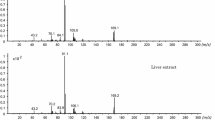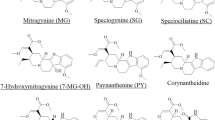Abstract
Purpose
Synthetic cathinones are powerful psychostimulants that have been associated with fatal intoxications. Because of changes that take place following death, postmortem toxicology results require careful interpretation. The purpose of this study was to evaluate the distribution of synthetic cathinones in postmortem specimens in a series of 50 cathinone-positive fatalities.
Methods
Liquid chromatography–quadrupole time-of-flight-mass spectrometry was used to quantitatively identify cathinones in central blood (n = 51), peripheral blood (n = 31), urine (n = 33), liver (n = 22), vitreous humor (n = 1) and stomach contents (n = 1). The distribution of cathinones and the potential for postmortem redistribution was assessed.
Results
Among the 50 cases investigated, a total of nine synthetic cathinones (α-PVP, ethylone, methylone, butylone, MDPV, methedrone, pentylone, 4-MEC, and MDPBP) were identified in 139 specimens. The number of specimens per case ranged from one to six. In cases that included central blood or liver, together with a peripheral blood source, the central/peripheral (C/P) or liver/peripheral (L/P) ratio was calculated to estimate the potential for postmortem redistribution (n = 21 C/P; n = 11 L/P). Methylone and ethylone appeared to exhibit the greatest potential for postmortem redistribution, producing C/P ratios of 4.0 (1.5–6.1) and 2.9 (0.5–9.2), respectively. In contrast, the C/P ratio for α-PVP was 1.1 (0.5–1.9). Differences in C/P ratios between methylone and α-PVP were statistically significant (α = 0.05).
Conclusions
Although synthetic cathinones may exhibit low to moderate postmortem redistribution, significant variability exists due to site- and time-dependent factors. This, in combination with their overall instability, necessitates careful interpretation of postmortem toxicology results.




Similar content being viewed by others
References
Cook DS, Braithwaite RA, Hale KA (2000) Estimating antemortem drug concentrations from postmortem blood samples: the influence of postmortem redistribution. J Clin Pathol 53:282–285
Pounder DJ, Jones GR (1990) Post-mortem drug redistribution—a toxicological nightmare. Forensic Sci Int 45:253–263
Jones GR, Pounder DJ (1987) Site dependence of drug concentrations in postmortem blood—a case study. J Anal Toxicol 11:186–190
McIntyre IM, Hamm CE, Sherrard JL, Gary RD, Burton CG, Mena O (2015) Acute 3,4-methylenedioxy-N-ethylcathinone (ethylone) intoxication and related fatality: a case report with postmortem concentrations. J Anal Toxicol 39:225–228
Dinis-Oliveira RJ, Carvalho F, Duarte JA, Remião F, Marques A, Santos A, Magalhães T (2010) Collection of biological samples in forensic toxicology. Toxicol Mech Methods 20:363–414
Drummer OH (2004) Postmortem toxicology of drugs of abuse. Forensic Sci Int 142:101–113
Barnhart FE, Fogacci JR, Reed DW (1999) Methamphetamine—a study of postmortem redistribution. J Anal Toxicol 23:69–70
Pélissier-Alicot A-L, Gaulier J-M, Champsaur P, Marquet P (2003) Mechanisms underlying postmortem redistribution of drugs: a review. J Anal Toxicol 27:533–544
Skopp G (2010) Postmortem toxicology. Forensic Sci Med Pathol 6:314–325
Baselt RC (2017) Disposition of toxic drugs and chemicals in man, 11th edn. Biomedical Publications, Seal Beach
Logan B, Weiss E, Harruff R (1996) Case report: distribution of methamphetamine in a massive fatal ingestion. J Forensic Sci 41:322–323
McIntyre I, Hamm C, Bader E (2011) Postmortem methamphetamine distribution. J Forensic Res 2:1–3
Elliott SP (2005) MDMA and MDA concentrations in antemortem and postmortem specimens in fatalities following hospital admission. J Anal Toxicol 29:296–300
Dams R, De Letter EA, Mortier KA, Cordonnier JA, Lambert WE, Piette MHA, Van Calenbergh S, De Leenheer AP (2003) Fatality due to combined use of the designer drugs MDMA and PMA: a distribution study. J Anal Toxicol 27:318–323
Rohrig TP, Prouty RW (1992) Tissue distribution of methylenedioxymethamphetamine. J Anal Toxicol 16:52–53
De Letter EA, Bouche M-PLA, Van Bocxlaer JF, Lambert WE, Piette MHA (2004) Interpretation of a 3,4-methylenedioxymethamphetamine (MDMA) blood level: discussion by means of a distribution study in two fatalities. Forensic Sci Int 141:85–90
De Letter EA, Clauwaert KM, Lambert WE, Van Bocxlaer JF, De Leenheer AP, Piette MHA (2002) Distribution study of 3,4-methylenedioxymethamphetamine and 3,4-methylenedioxyamphetamine in a fatal overdose. J Anal Toxicol 26:113–118
Kennedy MC (2010) Post-mortem drug concentrations. Intern Med J 40:183–187
Zhou M-J, Bouazzaoui S, Jones LE, Goodrich P, Bell SEJ, Sheldrake GN, Horton PN, Coles SJ, Fletcher NC (2015) Isolation and structural determination of non-racemic tertiary cathinone derivatives. Org Biomol Chem 13:9629–9636
Gibbons S, Zloh M (2010) An analysis of the ‘legal high’ mephedrone. Bioorg Med Chem Lett 20:4135–4139
Rojek S, Kłys M, Strona M, Maciów M, Kula K (2012) “Legal highs”—toxicity in the clinical and medico-legal aspect as exemplified by suicide with bk-MBDB administration. Forensic Sci Int 222:e1–e6
Marinetti LJ, Antonides HM (2013) Analysis of synthetic cathinones commonly found in bath salts in human performance and postmortem toxicology: method development, drug distribution and interpretation of results. J Anal Toxicol 37:135–146
Kesha K, Boggs CL, Ripple MG, Allan CH, Levine B, Jufer-Phipps R, Doyon S, Chi P, Fowler DR (2013) Methylenedioxypyrovalerone (“bath salts”), related death: case report and review of the literature. J Forensic Sci 58:1654–1659
Shimomura ET, Briones AJ, Warren WS, Addison JW, Knittel JL, Shoemaker SA, King TD, Bosy TZ (2016) Case report of methylone, oxymorphone and ethanol in a fatality case with tissue distribution. J Anal Toxicol 40:543–545
Pearson JM, Hargraves TL, Hair LS, Massucci CJ, Frazee CC, Garg U, Pietak BR (2012) Three fatal intoxications due to methylone. J Anal Toxicol 36:444–451
Cawrse BM, Levine B, Jufer RA, Fowler DR, Vorce SP, Dickson AJ, Holler JM (2012) Distribution of methylone in four postmortem cases. J Anal Toxicol 36:434–439
Barrios L, Grison-Hernando H, Boels D, Bouquie R, Monteil-Ganiere C, Clement R (2016) Death following ingestion of methylone. Int J Legal Med 130:381–385
Potocka-Banaś B, Janus T, Majdanik S, Banaś T, Dembińska T, Borowiak K (2017) Fatal intoxication with α-PVP, a synthetic cathinone derivative. J Forensic Sci 62:553–556
Hasegawa K, Suzuki O, Wurita A, Minakata K, Yamagishi I, Nozawa H, Gonmori K, Watanabe K (2014) Postmortem distribution of α-pyrrolidinovalerophenone and its metabolite in body fluids and solid tissues in a fatal poisoning case measured by LC-MS-MS with the standard addition method. Forensic Toxicol 32:225–234
Wyman JF, Lavins ES, Engelhart D, Armstrong EJ, Snell KD, Boggs PD, Taylor SM, Norris RN, Miller FP (2013) Postmortem tissue distribution of MDPV following lethal intoxication by “bath salts”. J Anal Toxicol 37:182–185
McIntyre IM, Hamm CE, Aldridge L, Nelson CL (2013) Acute methylone intoxication in an accidental drowning—a case report. Forensic Sci Int 231:e1–e3
Sykutera M, Cychowska M, Bloch-Boguslawska E (2015) A fatal case of pentedrone and α-pyrrolidinovalerophenone poisoning. J Anal Toxicol 39:324–329
McIntyre IM (2014) Liver and peripheral blood concentration ratio (L/P) as a marker of postmortem drug redistribution: a literature review. Forensic Sci Med Pathol 10:91–96
Glicksberg L, Bryand K, Kerrigan S (2016) Identification and quantification of synthetic cathinones in blood and urine using liquid chromatography-quadrupole/time of flight (LC-Q/TOF) mass spectrometry. J Chromatogr B 1035:91–103
Scientific Working Group for Forensic Toxicology (SWGTOX) (2013) Standard practices for method validation in forensic toxicology. J Anal Toxicol 37:452–474
Adamowicz P, Tokarczyk B, Stanaszek R, Slopianka M (2013) Fatal mephedrone intoxication—a case report. J Anal Toxicol 37:37–42
Dalpe-Scott M, Degouffe M, Garbutt D, Drost M (1995) A comparison of drug concentrations in postmortem cardiac and peripheral blood in 320 cases. Can Soc Forensic Sci J 28:113–121
Roettger JR (1990) The importance of blood collection site for the determination of basic drugs: a case with fluoxetine and diphenhydramine overdose. J Anal Toxicol 14:191–192
Moriya F, Hashimoto Y (1999) Redistribution of basic drugs into cardiac blood from surrounding tissues during early stages postmortem. J Forensic Sci 44:10–16
Glicksberg L, Kerrigan S (2017) Synthetic cathinone stability in blood. J Anal Toxicol 41:711–719
Glicksberg L, Kerrigan S (2017) Stability of synthetic cathinones in urine. J Anal Toxicol. https://doi.org/10.1093/jat/bkx091
Fura A, Harper TW, Zhang H, Fung L, Shyu WC (2003) Shift in pH of biological fluids during storage and processing: effect on bioanalysis. J Pharm Biomed Anal 32:513–522
Cook JD, Strauss KA, Caplan YH, LoDico CP, Bush DM (2007) Urine pH: the effects of time and temperature after collection. J Anal Toxicol 31:486–496
Ferner RE (2008) Post-mortem clinical pharmacology. Br J Clin Pharmacol 66:430–443
Acknowledgements
This project was supported by Award No. 2013-R2-CX-K006 awarded by the National Institute of Justice, Office of Justice Programs, U.S. Department of Justice. The opinions, findings, and conclusions or recommendations expressed in this publication are those of the author(s) and do not necessarily reflect those of the Department of Justice.
Author information
Authors and Affiliations
Corresponding author
Ethics declarations
Conflict of interest
The authors declare that they have no conflict of interest.
Ethical approval
All procedures involving biological samples obtained from human decedents were in accordance with the ethical standards of the Sam Houston State University Institutional Review Board (Protection of Human Subjects Committee) in accordance with 45CFR46.101(b) and with the 1964 Helsinki declaration and its later amendments or comparable ethical standards.
Rights and permissions
About this article
Cite this article
Glicksberg, L., Winecker, R., Miller, C. et al. Postmortem distribution and redistribution of synthetic cathinones. Forensic Toxicol 36, 291–303 (2018). https://doi.org/10.1007/s11419-018-0403-3
Received:
Accepted:
Published:
Issue Date:
DOI: https://doi.org/10.1007/s11419-018-0403-3




